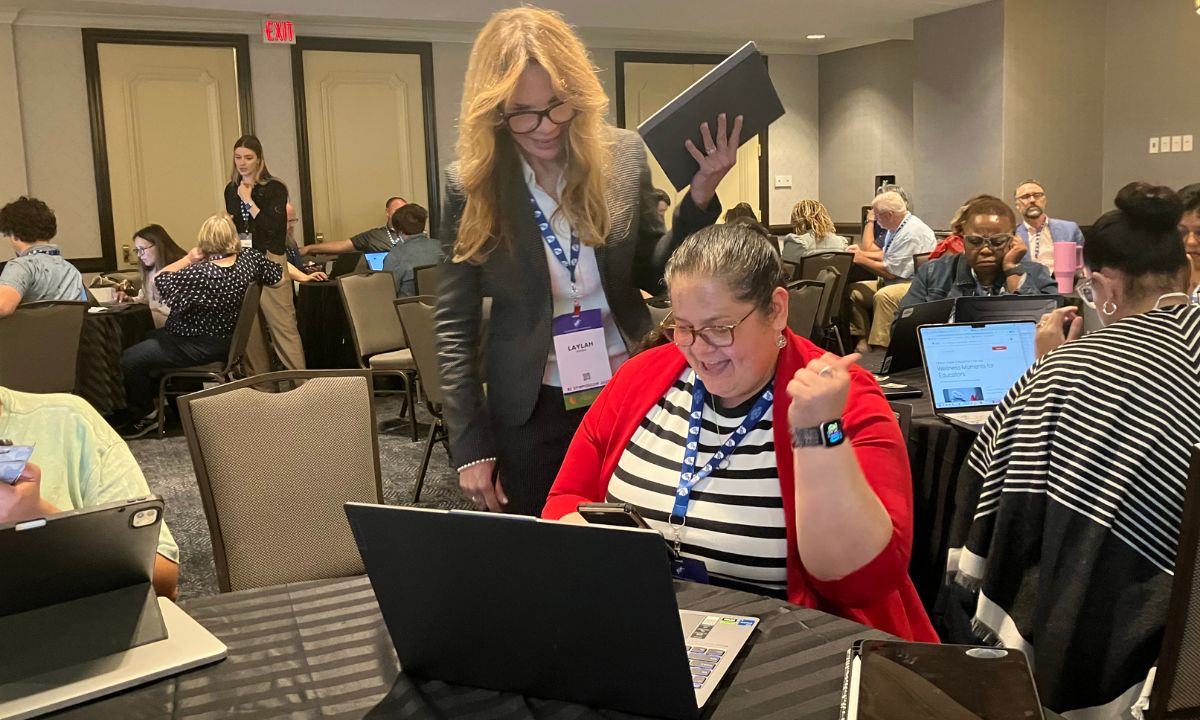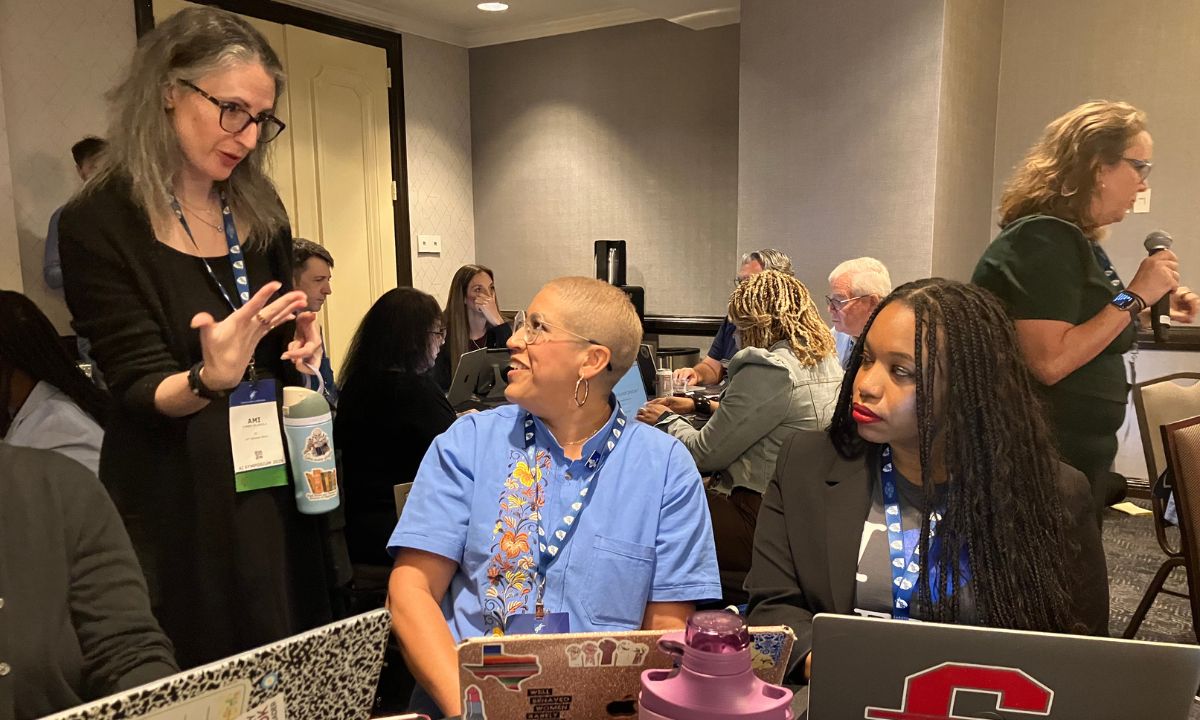Will New AI Academy Help Teachers or Just Improve Tech’s Bottom Line?
AFT says its AI training initiative will modernize teaching, while critics say it’s ‘a gigantic public experiment that no one has asked for.’

Get stories like this delivered straight to your inbox. Sign up for The 74 Newsletter
Washington, D.C.
Mariely Sanchez spent the last school year using generative artificial intelligence nearly every day in her classroom.
The Miami fourth-grade teacher began each morning by asking a chatbot — teachers in Miami-Dade have access not only to ChatGPT, but to Google’s Gemini and Microsoft’s Co-Pilot — to comb through Florida state standards and create reading passages for students. She’d also ask the AI to produce multiple-choice and short-response quizzes to test how well students understood the reading.
The assignments, she said, weren’t easy for students. She built them by using “difficult standards that students need more practice with” and prompting the AI to create materials.
Sanchez is spending her summer break learning more about AI, including its ethics, and helping colleagues do the same, warning:
We know it's not going to go away — it's here to stay, but we want to make sure we use it the right way.
Mariely Sanchez, fourth grade teacher
That effort got a big boost earlier last month, when the American Federation of Teachers announced that it would open an AI training center for educators in New York City, with $23 million in funding from OpenAI, Anthropic and Microsoft, three of the leading players in the generative AI marketplace.
AFT says it’ll open the National Academy for AI Instruction in Manhattan this fall, offering hands-on workshops for teachers. Over five years, it said, the academy will train 400,000 educators, or one in 10 U.S. teachers, effectively reaching the more than 7.2 million students they teach.
When she announced the academy in early July, AFT President Randi Weingarten said teachers face “huge challenges,” including navigating AI wisely, ethically and safely. “The question was whether we would be chasing it — or whether we would be trying to harness it.”
‘It’s the Wild West’
AFT, the nation’s second largest teachers’ union, envisions the academy working much like those that train carpenters, electricians and construction workers,“where the companies, where the corporations actually come to the union to create the kind of standards that are needed” for success, Weingarten said.
Microsoft, for example, has said it plans to give more than $4 billion in cash and technology services to train millions of people to use AI, underwriting efforts at schools, community colleges, technical colleges and nonprofits. The tech giant already boasts an AI partnership to train members of the larger AFL-CIO labor union, of which AFT is a member. And it’s creating a new training program, Microsoft Elevate Academy, to help 20 million people earn certificates in AI.
Rob Weil — AFT’s director of research, policy and field programs — said the new academy will bring high-quality training to a profession that so far has seen uneven opportunity for it.
“It’s the Wild West,” he said in an interview during a training session at the union’s annual conference in July. “It’s all over the place. You have some school districts that are out front, and they’re doing a lot of pretty good work.” But others are banning AI or simply ignoring it, he said, leaving teachers to fend for themselves at a time when students need them perhaps more than ever.
“We have to make our instruction better. We have to be better on engagement. We have a crisis of engagement in our schools, and these tools can help with that.”
AFT’s move has been met with equal parts cautious optimism and weary skepticism.
Writing in her Substack newsletter, ed-tech critic and AI skeptic Audrey Watters called AFT’s partnership with the tech companies “a gigantic public experiment that no one has asked for.”
Unions, she wrote, “should be one of the ways in which workers resist, rather than acquiesce to … the tech industry’s vision of the future.” By joining forces with big tech, she said, AFT is implicitly endorsing its products. “Teaching teachers how to use a suite of Microsoft tools does not help students as much as it helps Microsoft. Teaching teachers how to use a suite of Microsoft tools is not so much an ‘academy’ as a storefront.”
Benjamin Riley, who has also written critically about generative AI in education, said observers should “100% worry” that the new partnerships represent a play for market share.
“It’s very obvious from a product standpoint that they see education as one of, if not the primary, place to go with their product,” said Riley. “And the fact that AFT is willing to say, ‘Cool, let’s get some of that money and we’ll build a training center to help teachers use it,’ I can see why OpenAI would jump all over that.”
But he questioned whether AI training is what AFT members really want. He suggested instead that the union should recommit to helping teachers more deeply understand how learning works. “They haven’t been opposed to it,” he said, noting that it has long run an “Ask the Cognitive Scientist” column in the magazine it mails to members. “But in reality it just hasn’t been a priority. Improving pedagogy hasn’t really been, to my eyes, a union priority for a long time.”
Riley, who in 2024 founded the think tank Cognitive Resonance to explore AI issues, said an organization like AFT should ideally be thinking about whether embracing AI will lead to better outcomes for children — or whether it could “potentially erode and devalue the work of human teaching” while opening up schools as customers for AI companies.
Representatives of OpenAI and Anthropic did not immediately respond to requests for comment, but in an email, Microsoft’s Naria Santa Lucia said, “This isn’t about Microsoft’s technology, our focus is on making AI broadly accessible, so everyone has a fair shot at the future. If we collectively get this right, AI becomes a bridge to opportunity — not a barrier.”
During the academy’s unveiling, Chris Lehane, OpenAI’s chief global affairs officer, said AI technology “is coming — it is going to drive productivity gains. Can we ensure that those productivity gains are democratized so as many people as possible participate in them? And there is no better place to begin that work than in the classroom.”
OpenAI has noted that many of its users are students. In February, it said that more than one-third of college-aged young adults in the U.S. use ChatGPT, with one in four of their queries related to learning and school work.
While a few observers said the tech giants are making a play for market share among the nation’s K-12 students, they noted that the companies are also filling an important role.
“It’s welcome news that technology companies are bidding against each other — to outdo each other — to invest in public education,” said Zarek Drozda, executive director of Data Science 4 Everyone, a coalition of groups advancing data science education. “I think that’s exciting at a time when federal investment in education is uncertain. Seeing industry step up is quite meaningful.”
But he said he’s concerned that the training might stop short after teaching teachers — and by extension students — simply how to use AI. “Training needs to go beyond use,” he said. “If we want to train a generation of students to be AI-ready, internationally competitive, they have to understand how these tools work under the hood, when and why the tool might be wrong, and how they can customize LLMs [Large Language Models] or other models for their own pursuits, versus simply taking what’s given.”
He’s also concerned that the AFT has laid out a vision spanning just five years. “We want there to be a deep investment in upskilling teachers for the skills that they will need to adapt to, not just AI, but what is the AI model five years from now?” he said. “What is the next emerging technology that the field should be ready to adapt to?”
More than just a commitment to training, Drozda said, the union and its partners should commit to a long-term sustainability plan for teacher training to attract new, young career professionals to the field.

Alex Kotran, founder and CEO of the AI Education Project, agreed that investing in teacher training is worthwhile. “That’s a very big rock that needs to be moved.” But the reported $23 million commitment from the three tech giants “is a bit of a drop in the bucket” considering their valuations, “symbolic at best.”
That said, AFT’s involvement could make the training more palatable for many school district leaders, he noted, since one of the uncertainties in training efforts typically is whether unions will allow members to attend under contract rules. By taking the lead in developing the training academy, “the unions have planted a flag and said, ‘PD [professional development] is important.’”
All the same, tech companies are in the business of selling their products, making them imperfect messengers for AI literacy, he said. “They’re deeply incentivized on one side, and it isn’t necessarily for the benefit of students.”
Other industry watchers fear the partnership could be viewed as a high-profile bid for market share at a critical time in the AI industry’s history.
“This is a land-grab moment,” said Alex Sarlin, co-host of the Edtech Insiders podcast. “I mean, this technology is only three years old. There are already three or four major players in it, if you don’t count China, and they all want to be the one left standing.”
For its part, Google has said its suite of Gemini educational AI tools would become available for free to all educators with Google Workspace for Education accounts.
While it was the only major player not included in the AFT announcement, Sarlin said Google is, in some ways, “playing the incumbent in this because in K-12, they’re already there.” Given the dominance of Chromebook laptops, the management tool Google Classroom and its Google Certified Educator programs, the search giant is “embedded in K-12,” he said. “Open AI and Anthropic, they’re basically consumer products that are being used by teachers.”
‘Oh yeah, what could go wrong?’
Matt Miller, an Indiana high school Spanish teacher, educational consultant and author of six books for teachers, said his colleagues are hungry for high-quality, classroom-tested training, but that what they often get from AI companies is over-the-top talk about “how much the world is going to change and how we’re revolutionizing education,” with promises to help teachers work more efficiently.
Trainings typically skim over the fact that most students are simply using generative AI for “cognitive offloading,” Miller said, avoiding critical thinking and skill development “and letting AI do it for them.” Many teachers, meanwhile, are searching for ways to “AI-proof” their classrooms.
The sessions typically all end the same way, he said: “It all sort of funnels back to their product.”
Miller, whose latest book, in 2023, was AI for Educators, said the AFT/OpenAI/Anthropic partnership “scares the crap out of me.”
“Whenever you get that marriage between an organization and big companies, we just keep asking ourselves, ‘Oh, yeah, what could go wrong?’”
Money means influence, Miller said, so will the curriculum be “tool-agnostic? Is it going to be about the technology? Is it going to be about pedagogy? Or is it going to be a customized tutorial of how you can use our tool to do X, Y and Z?”
AFT’s Weil said those concerns are understandable but short-sighted. AI developers, he said, “don’t get to engage with us if you’re not going to be agnostic about the tools.” The academy’s directors talk openly to the developers “about how we have to have a practical, real relationship. This can’t be about product selling.”
More broadly, the partnerships are a way to exert influence upon how AI operates in schools and classrooms.
The only way we have a profession is if we control the profession.
Rob Weil, AFT’s director of research, policy and field programs
During the academy’s unveiling, Weingarten said its lessons will be “as open-source as possible,” not just for the union’s 1.8 million members but more broadly through its free Share My Lesson platform.
For his part, Weil said AI is “not going to go away. Nobody’s going to put AI back in the bottle. It’s here. The young people, for them to be successful in their jobs in the future, are going to have to know how to effectively and efficiently and safely use these tools. So why wouldn’t the education system help with that process?”
That’s likely the message that union leaders have been getting from members, said Sarlin, the podcast co-host. “There was probably a moment a couple years ago where they were sort of teetering, where they could have gone anti-AI,” he said. “But I think at this point that’s not where the puck is headed.”
Get stories like these delivered straight to your inbox. Sign up for The 74 Newsletter

;)
